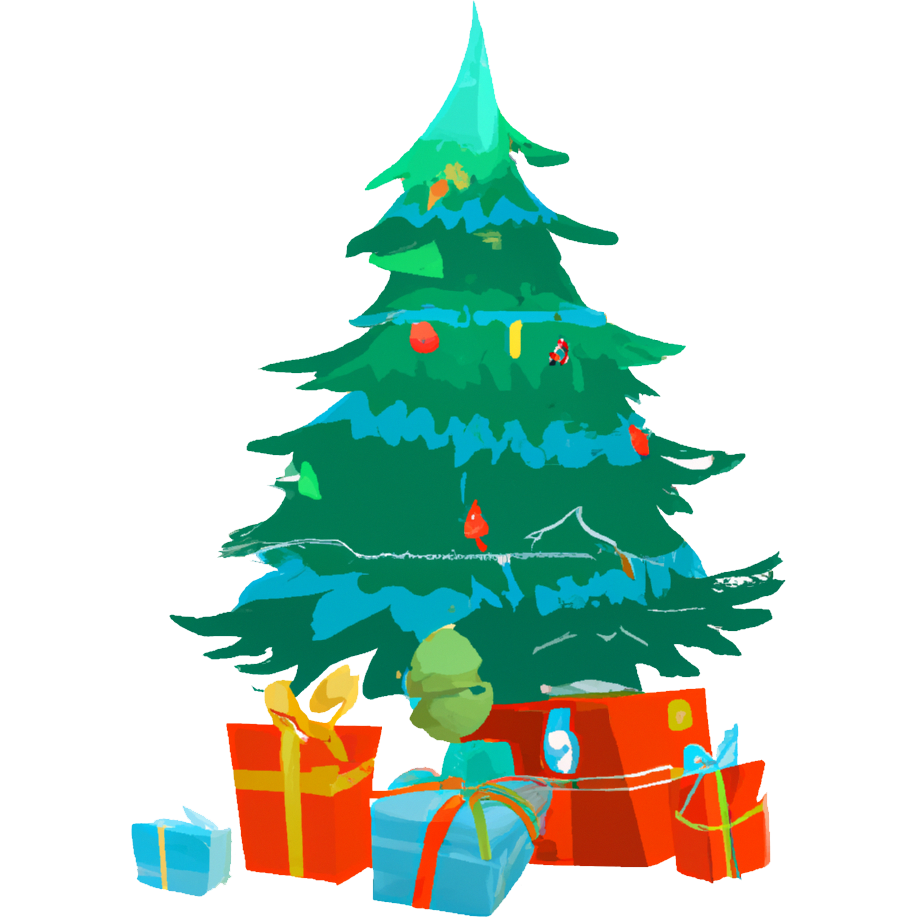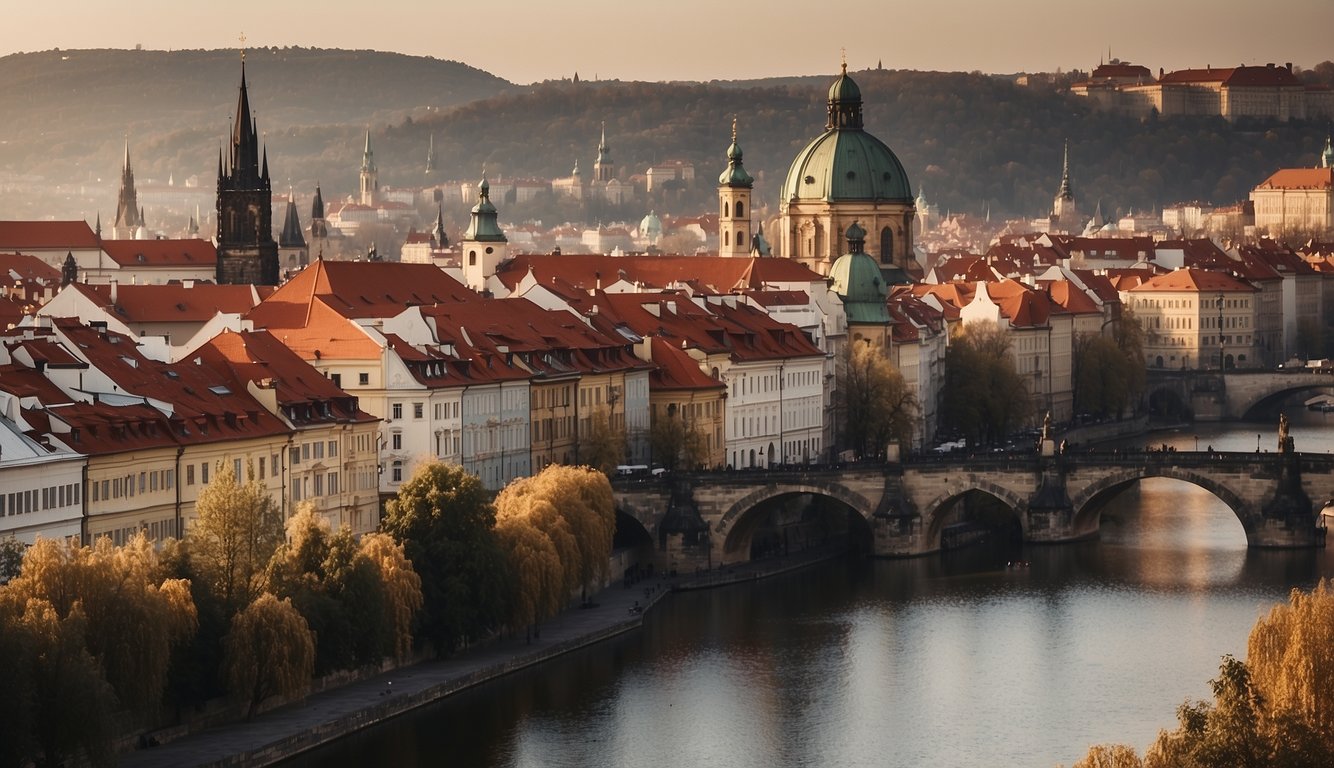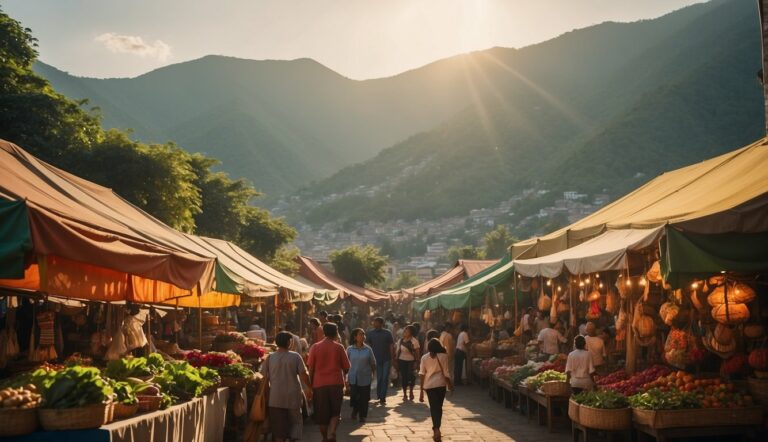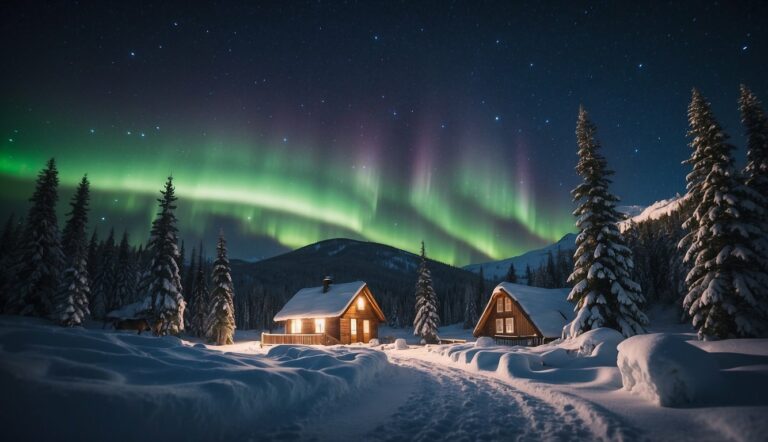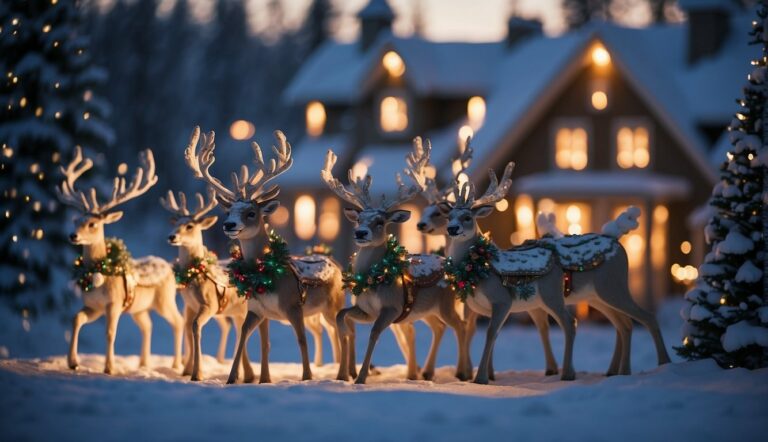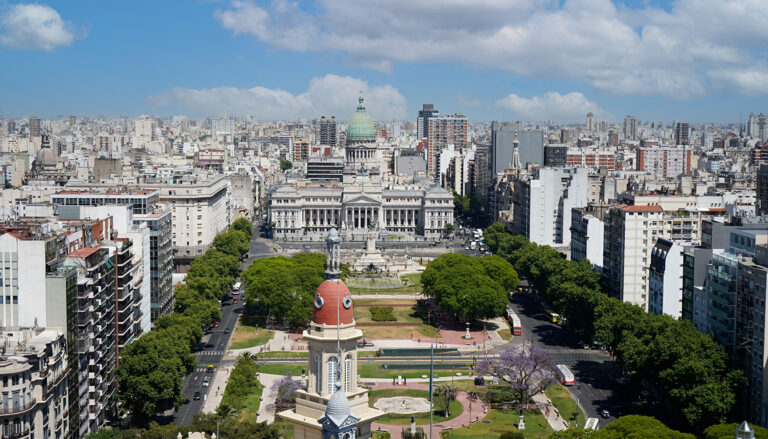Christmas in The Czech Republic: Exploring Czech Christmas Traditions in Prague and Beyond
Christmas in the Czech Republic is a time-honoured celebration deeply embedded in the nation’s culture. Known locally as Vánoce, this holiday season ushers in a festive atmosphere that blankets towns and cities with a sense of tradition and joy.
In Czechia, the Christmas period begins with Advent at the end of November and extends into the celebration of the Three Kings on January 6. However, the most celebrated day is Christmas Eve (December 24th), traditionally referred to as “Generous Day” (Štědrý den), when the main festivities take place.
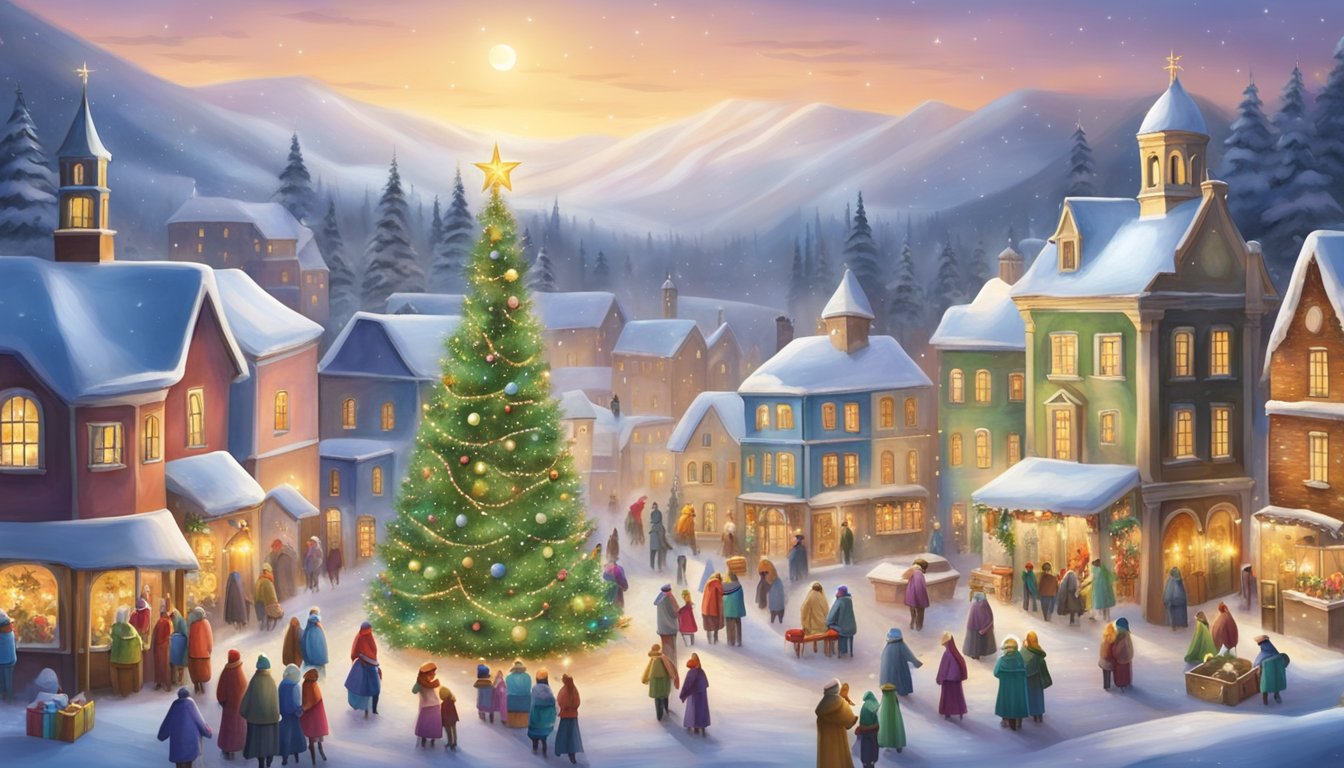
During this time, Czech Christmas customs come to life.
Homes are adorned with beautifully decorated Christmas trees, and an elaborate meal, which typically includes the famous fried carp and potato salad, is prepared for the Christmas Eve dinner.
Markets, like the Prague Christmas Market, glow with the warmth of mulled wine and the scent of traditional holiday treats.
The night abounds with superstitions, rituals, and games aimed to predict the future or bring good fortune, such as pouring molten lead into water and floating walnut shell candles.
The rich tapestry of the Czech Christmas celebrations interweaves religious observances, such as attending midnight mass, with these age-old folk customs, creating an enchanting experience that captures the true spirit of Vánoce.
Historical Origins and Significance
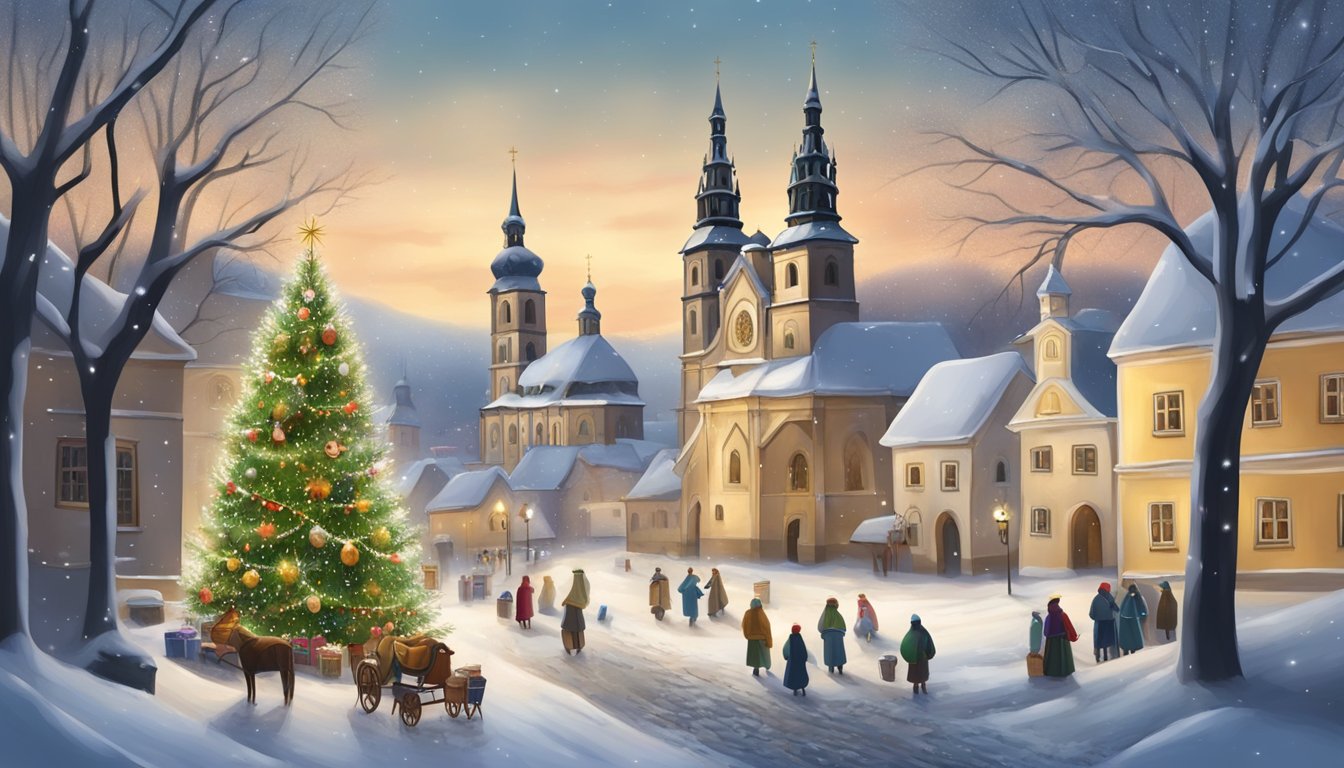
In the Czech Republic, Christmas is a holiday deeply rooted in pagan and Christian traditions that have evolved over the centuries. These historical nuances play a crucial role in today’s Czech Christmas celebrations.
Traditions From Pagan and Christian Roots
Pagan traditions predate the advent of Christianity in the Czech lands. The winter solstice, the shortest day and longest night of the year, was celebrated with rituals intended to ensure a good harvest, ward off evil spirits, and honour the cycle of nature.
These practices influenced how the Czechs celebrated the seasonal turn, setting the foundation for future festivities.
With the introduction of Christianity, which gradually became the dominant religion in the region, new layers were added to the existing customs.
The Christianization process often involved adapting pagan traditions to fit Christian beliefs. For example, the lighting of candles and yule logs, a common pagan practice to celebrate the return of light, was reinterpreted within the Christian framework as a symbol of the light of Christ.
Evolution of Czech Christmas Celebrations
Various historical and cultural shifts have influenced the transformation of the Czech Republic’s Christmas celebrations.
From a predominantly Christian society in the early 20th century, the Czech Republic has become more secular, with a significant decrease in the population identifying as Christian today.
However, many Christian customs have been retained, often merging with local folklore to create unique traditions.
One such example is the Christmas dinner served on December 24th, traditionally consisting of fried carp and potato salad. This dinner showcases an amalgamation of older customs with Christian fasting practices before the Christmas feast.
Despite the changes in religious beliefs over time, Czechs continue to honour Christmas as a Christian holiday and a cultural event enriched by its historical origins.
Advent and Preparation
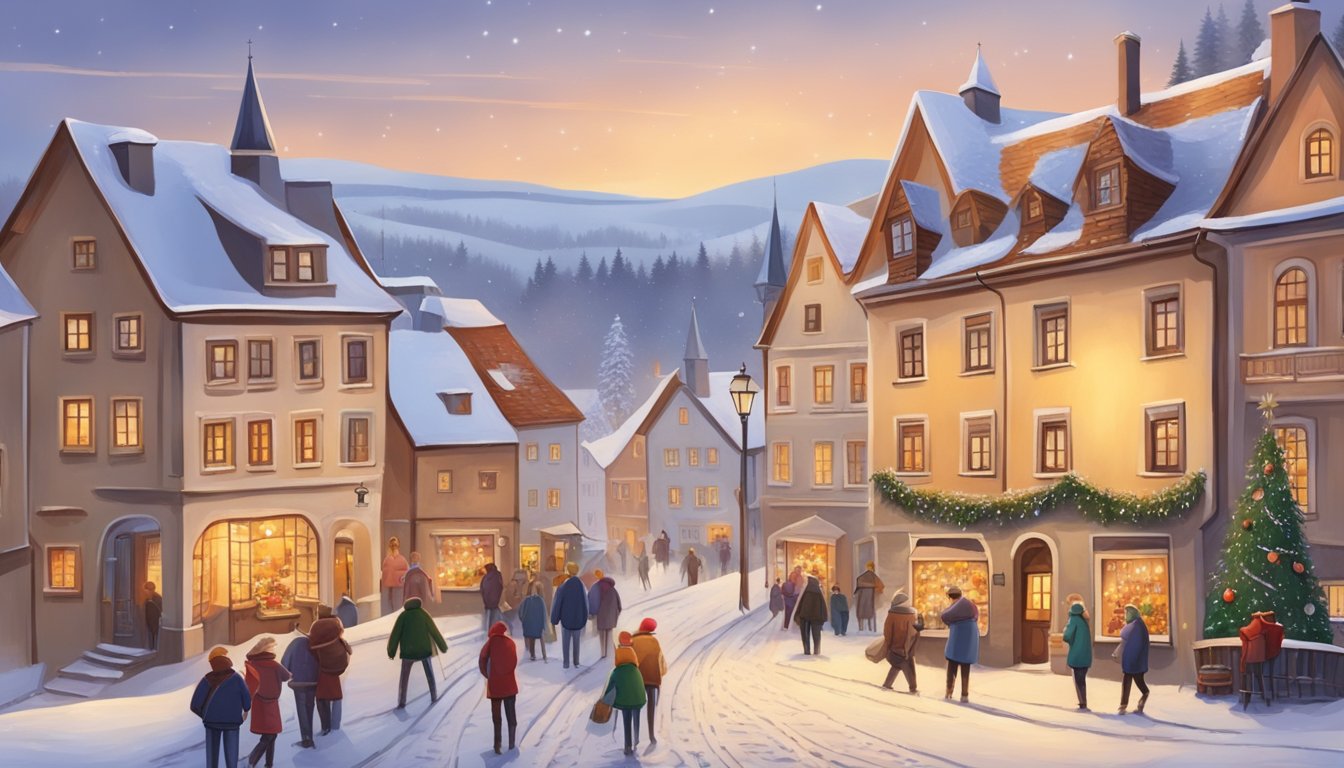
In the Czech Republic, the lead-up to Christmas is marked by a period of anticipation and readiness called Advent, starting four Sundays before Christmas Eve. This season is characterized by a deep-rooted cultural heritage that intertwines with religious practices and long-held customs.
Advent Wreaths and Calendars
An essential component of Advent in the Czech Republic is the Advent wreath, made of evergreens symbolizing eternal life and adorned with four candles.
These candles represent hope, peace, joy, and love — core tenets of the Advent message.
One candle is lit each Sunday, with each week adding more light leading up to Christmas, reflecting the growing anticipation for the holiday.
- First Sunday: The candle of hope
- Second Sunday: The candle of peace
- Third Sunday: The candle of joy
- Fourth Sunday: The candle of love
In addition to wreaths, Advent calendars are a daily reminder of the approaching Christmas Day. Behind each calendar’s door lies a small gift or sweet, building excitement, especially among children, as December 25th draws near.
The December Festivities and Fasting Period
The spirit of Christmas weaves through December in a tapestry of lights, markets, and festive decorations.
Czech cities and villages illuminate their Christmas trees and start their Christmas markets, creating a festive atmosphere that brings communities together in preparation for Christmas.
Many families also engage in creating nativity scenes and other preparations for the holiday.
Traditionally, the anticipation of Advent was coupled with fasting, reflecting a time for inner reflection and preparation.
This fasting period leads to a feast on December 25th, known as Generous Day, when families come together to enjoy a banquet symbolizing abundance and gratitude.
However, in contemporary practices, fasting is less stringent, and the focus has shifted more towards the many preparations leading to the celebration of Christmas.
Christmas Eve Customs
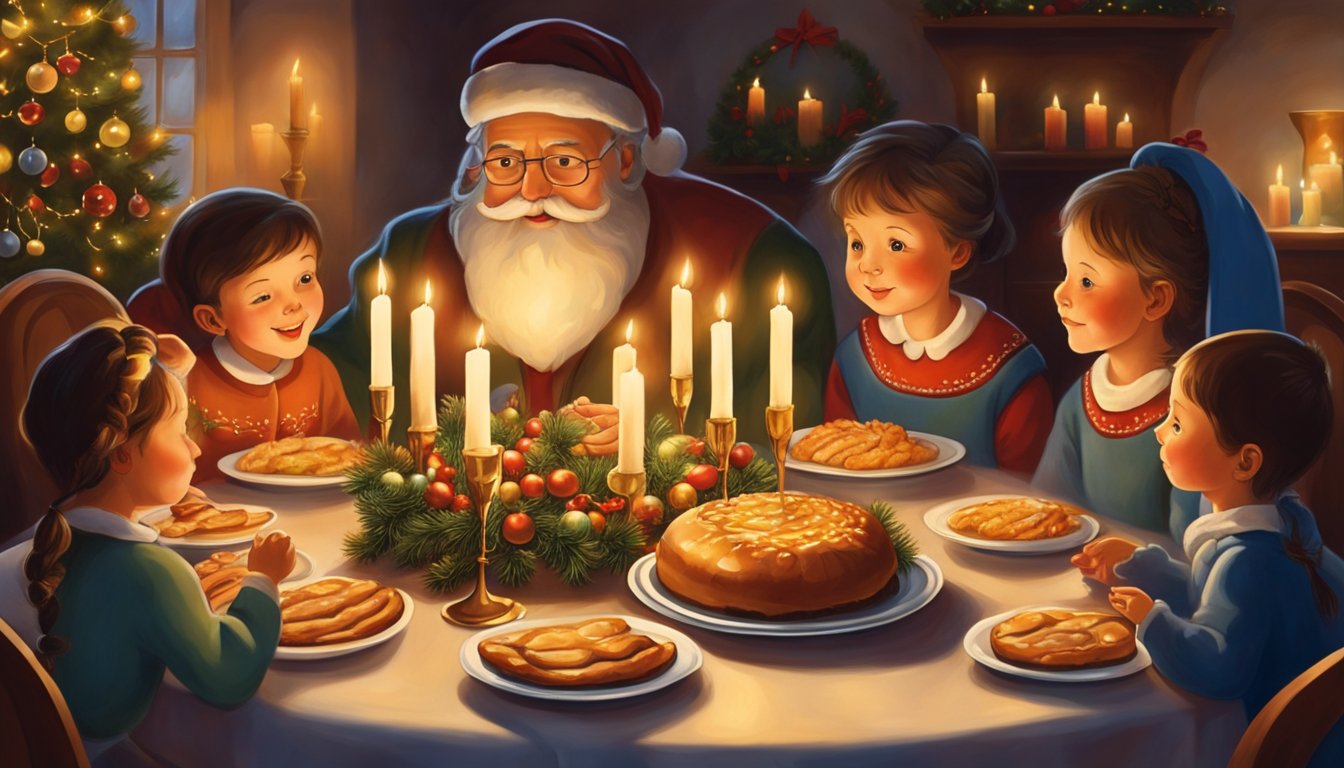
Christmas Eve in the Czech Republic is imbued with long-standing traditions, from a dinner rich in symbolism to the unique practice of gift distribution with a playful nod to Baby Jesus’ role.
The Rich Symbolism of Christmas Eve Dinner
The focal point of Czech Christmas Eve is undoubtedly the carefully prepared dinner laden with symbolism.
The Dinner Menu features a variety of dishes where each has its significance:
Fish Soup: Often served as a starter, setting a warm and inviting tone for the evening meal.
Carp: This fish becomes the centrepiece of the Christmas Eve dinner and is typically accompanied by potato salad.
Apples: They are cut crosswise to reveal a star pattern. The appearance of a perfect star is believed to bring good health.
The presence of fish scales, often from the carp, under plates or tablecloths is a symbolic custom believed to attract wealth to the household in the coming year.
Gift-Giving and Baby Jesus
The exchanging of presents is a deeply ingrained component of Christmas Eve:
Presents are typically exchanged after dinner. Unlike many Western countries where Santa Claus is central, Baby Jesus is said to be the bringer of gifts in the Czech Republic.
The ambience for the evening is enhanced with festive decorations and the soft light of candles, which add a peaceful glow to the joyous family gathering.
Festive Foods and Feasting

The Czech Republic hosts a splendid array of foods and sweets during the Christmas holidays, with a traditional dinner and delightful treats integral to the festive celebrations.
Traditional Czech Christmas Dishes
A centrepiece of the Czech Christmas dinner table is the fried carp, traditionally served with a rich potato salad.
The carp is breaded with flour, egg, and breadcrumbs before frying, creating a savoury main dish that is both crispy and tender. The accompanying potato salad mixes boiled potatoes, carrots, peas, eggs, and pickled cucumbers, often seasoned with mustard and mayonnaise.
Another festive staple is sauerkraut, which usually accompanies main courses such as roasted meats or sausages, adding a tangy contrast to the rich flavours of the meal.
Sweets and Treats of the Holiday Season
No Czech Christmas would be complete without a variety of cookies, known locally as cukroví.
These sweet treats come in numerous shapes and flavors, adorned with sugar, honey, nuts, and chocolate. They are the result of family baking sessions that are as much about bonding as they are about the end product.
Apple Strudel: This celebrated dessert, made with thin layers of dough packed with a sweet mixture of apples, cinnamon, sugar, and raisins, holds a cherished place in the Czech Christmas tradition.
Perníčky (Gingerbread Cookies): Scented with warming spices and decorated with intricate icing, these gingerbread cookies are not just delectable but also serve as festive décor.
Czech Christmas Symbols
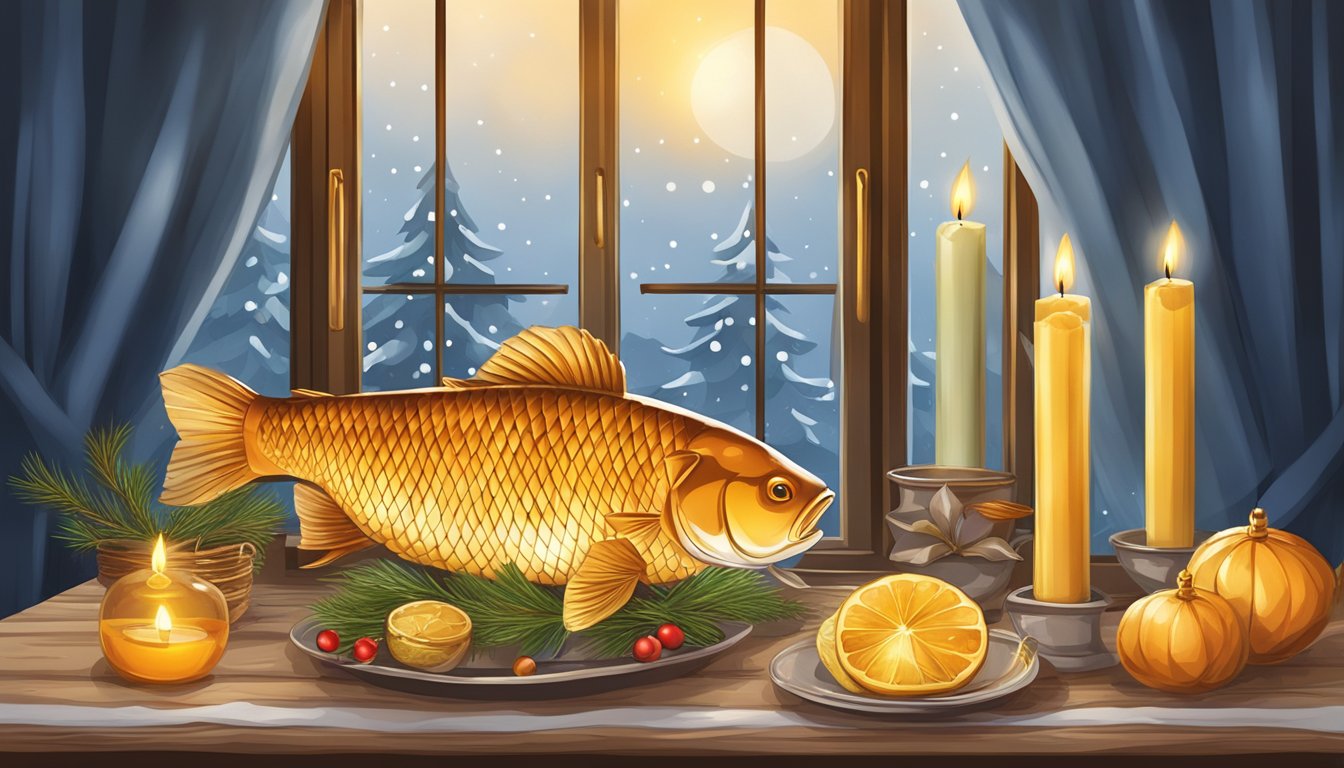
Czech Christmas is rich in a variety of symbols that range from religious to traditional, each with its own significance and history.
Nativity Scenes and Christmas Trees
In the Czech Republic, nativity scenes (Betlémy in Czech) are honoured as representations of the birth of Jesus Christ.
These scenes are elaborately crafted, often beautifully detailed, and displayed in public spaces and homes.
Christmas trees, introduced in the 19th century, are now a central symbol of the holiday in Czech homes. They are typically adorned with a blend of traditional and modern decorations.
Legends and Folklore
Czech Christmas lore is interwoven with various legends and superstitions.
Enigmatic symbols like the golden pig are foretellers of luck and fortune. According to a custom, those who fast throughout Christmas Eve have the chance to glimpse this symbol of prosperity.
Mistletoe: This plant is not only used for decoration but is also considered a symbol of love and unity.
Superstitions: Folk customs often involve predicting the future, like slicing an apple to inspect its core for signs of the year ahead.
Cultural Celebrations and Performances

During the festive season in the Czech Republic, cultural celebrations and performances are integral to the Christmas atmosphere. Vibrant markets and traditional religious services capture the essence of Czech Christmas.
Christmas Markets and Open Air Museums
In Prague, the Old Town Square transforms into a picturesque Christmas market, a hub of activity where locals and tourists can indulge in the holiday spirit.
Stalls brimming with handcrafted goods, seasonal treats, and warm beverages create a sociable environment.
Open-air museums and castles across the Czech Republic follow suit, offering a historical backdrop to these festive gatherings. Here, the customs of bygone eras come to life amidst the holiday cheer.
Carol Singing and Religious Services
Carol singing is a cherished tradition in the Czech Republic. Groups of carolers often visit homes and public spaces, sharing songs passed down through generations.
Many families attend midnight mass at local churches on Christmas Eve, a pivotal part of the Czech Christmas traditions.
These religious services are steeped in solemnity and reflection, juxtaposed with the joyous voices of carol singers echoing through the crisp winter air.
Christmas After Eve

After the anticipation and celebration of Christmas Eve, Czech traditions continue with peacefulness and reflection during Christmas Day and St. Stephen’s Day, followed by a gradual wind-down of the festive period.
Christmas Day and St. Stephen’s Day
On Christmas Day (December 25), families often attend church services in the morning.
It is a time for peaceful celebration, and for many, especially those who did not attend a midnight mass, it is a chance to reflect on the spiritual aspect of Christmas.
Typically, this is a quieter day with an emphasis on relaxation and enjoying the company of loved ones.
St. Stephen’s Day, also known as the Second Christmas Day, falls on December 26.
This day is named after Saint Stephen, the first Christian martyr, and continues the Christmas festivities.
Families usually spend this time together, with many remaining at home to savour the holiday atmosphere and partake in any leftover treats from the previous days.
Continuing Festivities and the End of the Christmas Cycle
The period after Christmas Eve leading to the New Year is often filled with ongoing celebrations and social gatherings.
Gifts exchanged over the Christmas period are enjoyed, and there may be visits from distant relatives or tourists experiencing the Czech Christmas culture.
The intricate rituals that characterize the beginning of the Czech Christmas cycle, starting with St. Nicholas Day on December 5, conclude as families and communities prepare for the New Year.
However, the festive spirit remains vibrant in homes and public spaces, ensuring a seamless and joyful transition into the next year.
Modern Practices and International Influence
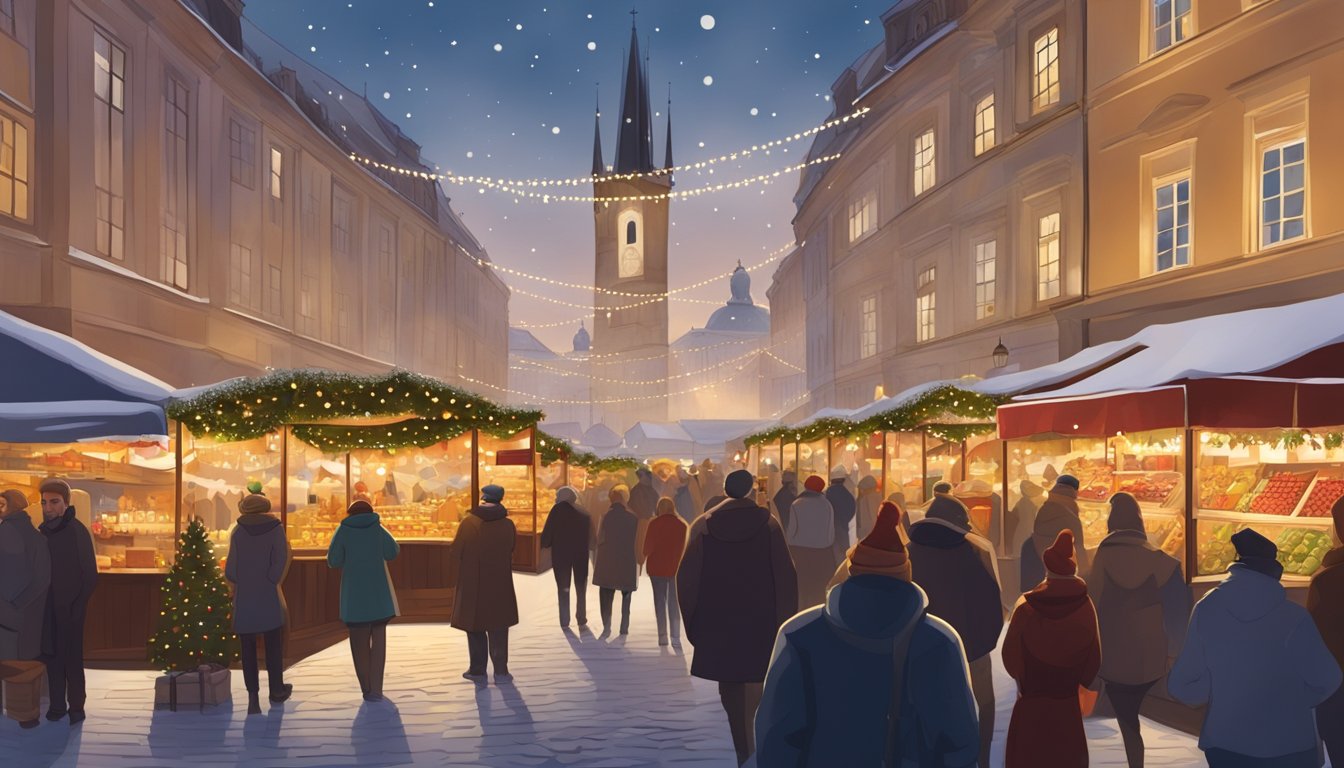
The Christmas season in the Czech Republic intertwines deep-rooted customs with contemporary practices. While tradition holds strong in Czech celebrations, international influences have introduced additional elements, notably in popular culture and tourism.
Santa Claus Versus the Czech Ježíšek
The traditional Czech gift-bringer is Ježíšek, or Baby Jesus, who brings presents to children on Christmas Eve.
Unlike Santa Claus, known internationally by various names, Ježíšek does not have a physical form in Czech culture, offering a unique and mystical touch to the holiday.
However, with globalisation, the image of Santa Claus, with his signature red outfit and beard, is becoming more familiar in Czech shops and media during the holiday season.
Christmas Tourism in the Czech Republic
The festive atmosphere of Prague during Christmas is a significant draw for tourists.
Locations such as Prague Castle and Old Town Square become epicentres of holiday spirit, adorned with impressive decorations.
The Christmas markets in Prague are especially notable; Old Town Square’s market is famed for its vibrant stalls and traditional Czech Christmas treats.
They provide an authentic experience of Czech Christmas traditions for visitors, while also reflecting the international appeal of these seasonal celebrations.
Unique Regional Variations
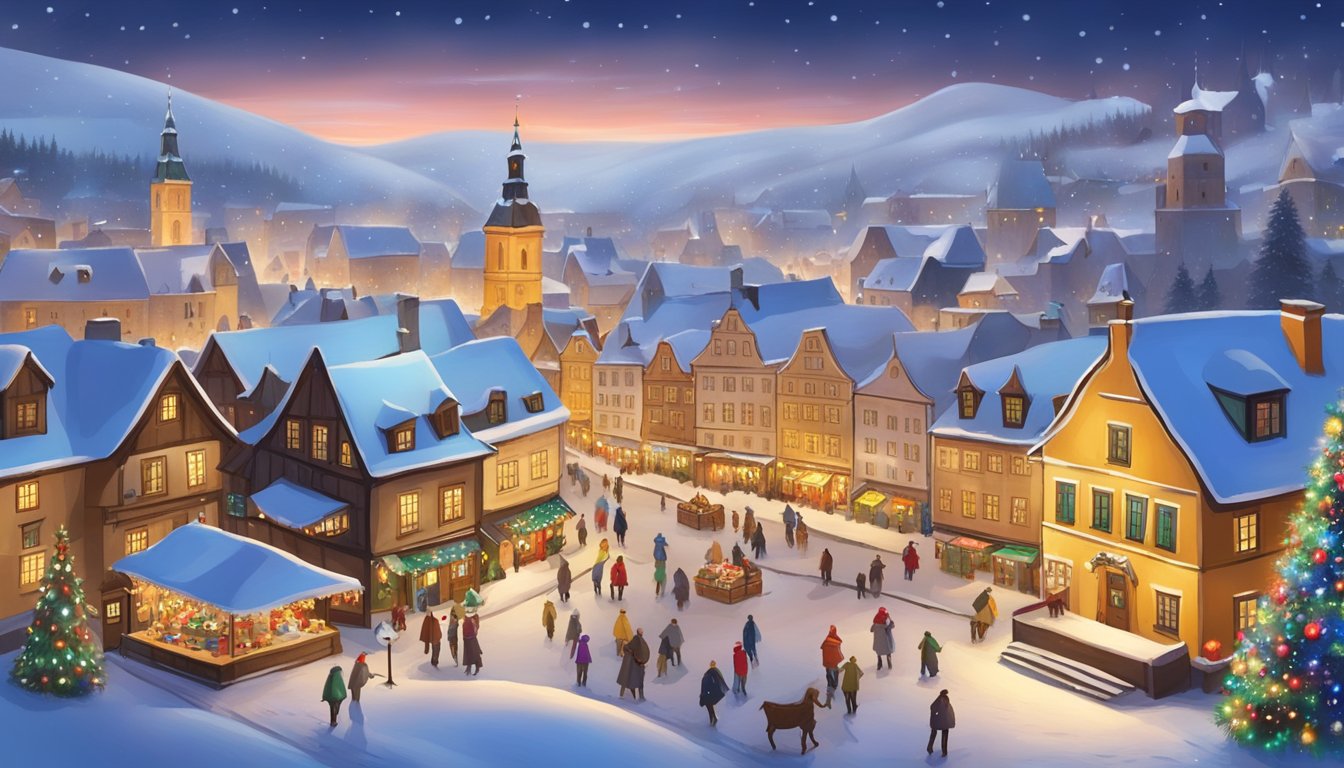
As the Czech Republic prepares for Christmas, distinctive local practices and the celebration of regional tastes come to the forefront.
Local Customs Across the Czech Republic
The Czech Republic boasts a tapestry of local customs that vary widely.
For instance, Rožnov pod Radhoštěm, nestled in the Beskydy Mountains, is renowned for its Christmas exhibitions.
These exhibitions showcase traditional Wallachian cribs, marking a unique blend of regional history and Christmas celebrations. Elsewhere, mountains play a key role in influencing local traditions, with towns and villages often weaving elements of their mountainous heritage into Christmas festivities.
Christmas in Czech Villages and Towns
In Czech villages and towns, Christmas is a display of local heritage and culinary traditions.
Regional dishes take centre stage, with recipe variations reflecting the area’s culture.
Fish, particularly Christmas carp, is a staple, and in some areas, it is customary to buy live carp and keep them in bathtubs before preparing them for Christmas Eve dinner.
Mushrooms, foraged locally, are often featured in festive meals, emphasizing the Czech’s connection with nature and local sourcing.
Frequently Asked Questions
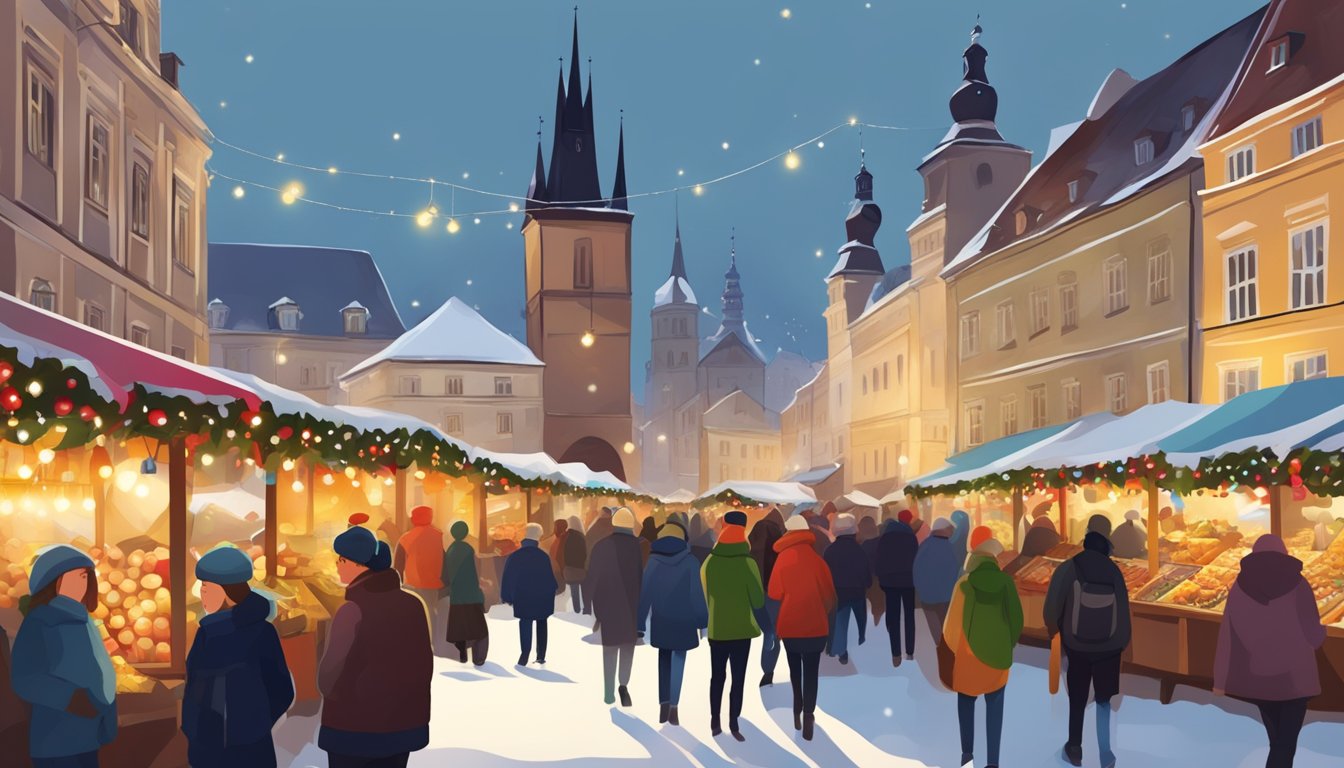
What traditional foods are served during Christmas in the Czech Republic?
Traditional Czech Christmas meals often include fish soup and fried carp. The dinner typically culminates with a dessert of vánočka, a braided bread.
What are some unique Czech Christmas traditions?
Unique Czech Christmas traditions include creating elaborate nativity scenes and practising superstitions such as cutting an apple in half to predict fortune in the coming year.
What is the significance of Christmas Eve in Czech culture?
Christmas Eve is the most significant day in the Czech Christmas season, often attended with a family dinner and concluded with many attending the midnight mass.
How are Christmas markets in the Czech Republic distinct from those in other countries?
The Christmas markets in the Czech Republic are distinguished by their charming atmosphere, traditional crafts, and unique food items such as trdelník, a cinnamon pastry.
What are typical Czech Christmas decorations?
Typical Czech Christmas decorations include hand-blown glass ornaments, straw decorations, and nativity scenes prominently displayed throughout the holiday season.
How is the Christmas season typically celebrated in the Czech Republic?
The Christmas season in the Czech Republic is marked by distinctive customs, such as Advent, the building of nativity scenes, and the baking of traditional Christmas cookies.
